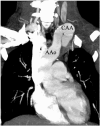Congenital anomalies of the aortic arch: evaluation with the use of multidetector computed tomography
- PMID: 19270864
- PMCID: PMC2651449
- DOI: 10.3348/kjr.2009.10.2.176
Congenital anomalies of the aortic arch: evaluation with the use of multidetector computed tomography
Abstract
Congenital anomalies of the aortic arch have clinical importance, as the anomalies may be associated with vascular rings or other congenital cardiovascular diseases. Multidetector computed tomography (MDCT) angiography enables one to display the detailed anatomy of vascular structures and the spatial relationships with adjacent organs; this ability is the greatest advantage of the use of MDCT angiography in comparison to other imaging modalities in the evaluation of the congenital anomalies of the aortic arch. In this review article, we illustrate 16-slice MDCT angiography appearances of congenital anomalies of the aortic arch.
Keywords: Angiography; Aortic arch anomalies; Multidetector computed tomography.
Figures
















References
-
- Grathwohl KW, Afifi AY, Dillard TA, Olson JP, Heric BR. Vascular rings of the thoracic aorta in adults. Am Surg. 1999;65:1077–1083. - PubMed
-
- Lee EY, Siegel MJ, Hildebolt CF, Gutierrez FR, Bhalla S, Fallah JH. MDCT evaluation of thoracic aortic anomalies in pediatric patients and young adults: comparison of axial, multiplanar, and 3D images. AJR Am J Roentgenol. 2004;182:777–784. - PubMed
-
- Gilkeson RC, Ciancibello L, Zahka K. Multidetector CT evaluation of congenital heart disease in pediatric and adult patients. AJR Am J Roentgenol. 2003;180:973–980. - PubMed
-
- Edwards JE. Anomalies of the derivatives of the aortic arch system. Med Clin North Am. 1948;32:925–949. - PubMed
-
- Stewart JR, Kincaid OW, Edwards JE. An atlas of vascular rings and related malformations of the aortic arch system. Illinois: Springfield; 1964. pp. 12–131.

